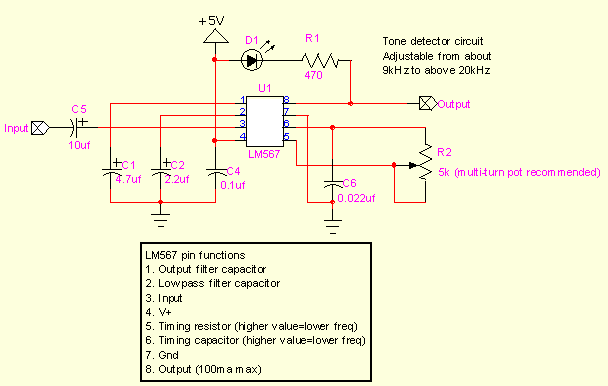| |
Tone
Detector Circuit (updated
5/2008)
Purpose:
This circuit detects a tone from an audio device such as an MP3 or CD
player and can be used to trigger a prop. An example for its use would
be a pair of talking heads where you need to trigger a prop, like a
pneumatic pop-up, at a certain time. You'd record the audio for each
head on separate tracks of a cd, then add short tones (the frequency
of the tones would be out of the range of normal hearing) on one (or
both) of the tracks to activate the prop.
I
experimented with this circuit a couple of years ago but only recently
got around to using it in a prop. So far, it has worked very well. Here
are a few observations on using it:
- I initially tried
the circuit using low frequency tones (i.e. 20Hz). I found that for
reliability, the length of the recorded tone had to be at least 0.5
seconds long. This was too long for the prop I was building so I decided
to try tones above 15k. I was able to use 0.05 second long tones without
any problem.
- I generate the
tones using the audio editing program Goldwave
(Expression Evaluator/Waves/Sine, f=18,000Hz). Audacity,
a free audio program, also has an easy to use tone generator.
- I use the "mix"
function in Goldwave to insert the tone into an existing audio track.
The tone can be placed anywhere, on existing audio or on a dead spot,
it really doesn't matter.
- I'm using an MP3
player (uMP3
from Rogue Robotics) and have two sound files, one is a two minute
long 18k tone for use in calibrating the circuit and the other is my
program audio.
- To calibrate the
circuit, play the continuous tone and adjust the 5k pot until the led
illuminates. The circuit has a fairly narrow bandwidth but using a multi-turn
pot, the led will stay on for about two turns. Be sure to center the
pot within this range.
- Play the audio
with the output split between the amplifier/speaker and the detector
circuit.
- My only concern
right now is how stable the circuit will be with changing temperatures.
With more use, I'm sure I'll learn the answer to this and will report
back what I find.
- Update
from Halloween 2006: This circuit worked extremely
well. There were absolutely no missed tones! It sat outside for several
days with temperatures ranging from the low 40's to the upper 70's.
- Update
from Halloween 2007:
Once again, the circuit worked very well. Set it and forget it, that's
the kind of circuit I like!!
The output of the
circuit goes low when a tone is detected, so it can be attached directly
to a microcontroller (I'm using it with a BASIC
Stamp2) or through a switching transistor to drive a relay or whatever.
The output of the LM 567 will sink 100ma.
The LM567 can be
set to a wide range of frequencies, so you can potentially use different
tones for different purposes. The circuit below can be adjusted from
about 9kHz to well over 20kHz. By substituting the capacitor C6 with
a higher value, you can lower the frequency. The approximate formula
is f=1/(R2 x C6) (capacitance is in farads). With a 10uf capacitor,
you should be able to get down to around 20Hz.
Click
here for a data sheet on the LM567. They are available from various
suppliers, Digikey has them for
under $2.
|
|

